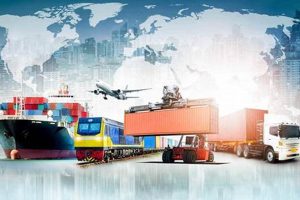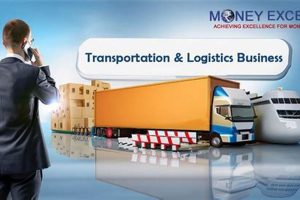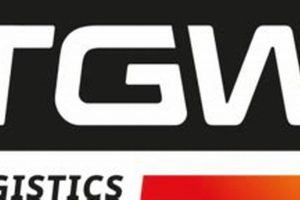
Logistics involves managing the flow of goods, information, and other resources from the point of origin to the point of consumption, and the costliest part of logistics is transportation.
Transportation costs can account for up to 60% of total logistics costs, depending on the industry and the distance the goods are being shipped. There are a number of factors that can affect transportation costs, including the mode of transportation, the distance the goods are being shipped, and the weight and size of the goods.
Businesses can take a number of steps to reduce transportation costs, such as negotiating with carriers, optimizing shipping routes, and consolidating shipments. In some cases, it may also be possible to reduce transportation costs by using alternative modes of transportation, such as rail or sea.
1. Mode of transportation
The mode of transportation is one of the most important factors to consider when calculating the cost of logistics. Different modes of transportation have different costs associated with them, and the cost of shipping goods can vary significantly depending on the mode of transportation chosen.
- Air freight: Air freight is the most expensive mode of transportation, but it is also the fastest. Air freight is typically used for shipping high-value goods or goods that need to be delivered quickly.
- Ocean freight: Ocean freight is the least expensive mode of transportation, but it is also the slowest. Ocean freight is typically used for shipping low-value goods or goods that are not time-sensitive.
- Road freight: Road freight is a relatively inexpensive mode of transportation, and it is also relatively fast. Road freight is typically used for shipping goods that are not time-sensitive and that can be transported in a truck.
- Rail freight: Rail freight is a relatively inexpensive mode of transportation, but it is also relatively slow. Rail freight is typically used for shipping bulk goods or goods that are not time-sensitive.
The cost of transportation can also be affected by the distance the goods are being shipped, the weight and size of the goods, and the fuel costs. When choosing a mode of transportation, it is important to consider all of these factors to ensure that you are choosing the most cost-effective option.
2. Distance
The distance the goods are being shipped is a major factor in determining the cost of logistics. The longer the distance, the higher the cost of transportation. This is because longer distances require more fuel, more labor, and more time. Additionally, longer distances may also require the use of more expensive modes of transportation, such as air freight.
- Fuel costs: Fuel costs are a major component of transportation costs. The longer the distance the goods are being shipped, the more fuel will be required, and the higher the cost of transportation will be.
- Labor costs: Labor costs are another major component of transportation costs. The longer the distance the goods are being shipped, the more labor will be required to load, unload, and transport the goods, and the higher the cost of transportation will be.
- Time: Time is also a factor in transportation costs. The longer the distance the goods are being shipped, the longer it will take to transport the goods, and the higher the cost of transportation will be.
- Mode of transportation: The mode of transportation used to ship the goods can also be affected by the distance the goods are being shipped. For example, air freight is typically more expensive than ocean freight, but it is also faster. If the goods are being shipped a long distance, it may be more cost-effective to use a slower mode of transportation, such as ocean freight.
Businesses can take a number of steps to reduce the cost of transportation, such as negotiating with carriers, optimizing shipping routes, and consolidating shipments. However, the distance the goods are being shipped is a major factor that will always affect the cost of transportation.
3. Weight and size
The weight and size of the goods are important factors to consider when calculating the cost of logistics. Heavier and larger goods are more expensive to ship because they require more fuel, more labor, and more space. Additionally, heavier and larger goods may also require the use of specialized equipment, such as forklifts or cranes, which can further increase the cost of shipping.
For example, shipping a 10-pound box of books will cost less than shipping a 100-pound box of books. This is because the heavier box will require more fuel to transport, and it may also require the use of specialized equipment to load and unload the box.
Similarly, shipping a large box of furniture will cost more than shipping a small box of furniture. This is because the larger box will take up more space on the truck or ship, and it may also be more difficult to load and unload.
Businesses can take a number of steps to reduce the cost of shipping heavy and large goods, such as negotiating with carriers, optimizing shipping routes, and consolidating shipments. However, it is important to remember that the weight and size of the goods will always be a factor in determining the cost of shipping.
Understanding the connection between weight, size, and shipping costs is essential for businesses that want to optimize their logistics operations. By taking into account the weight and size of their goods, businesses can make informed decisions about the best way to ship their goods and minimize their shipping costs.
4. Fuel costs
Fuel costs are a major component of transportation costs, and they can have a significant impact on the overall cost of logistics. When fuel costs are high, transportation costs will also be high. This is because fuel is used to power the vehicles that transport goods, and when fuel costs are high, it costs more to operate these vehicles.
For example, if a trucking company has to pay more for fuel, it will have to pass on those costs to its customers in the form of higher shipping rates. This can have a ripple effect throughout the supply chain, as higher shipping costs can lead to higher prices for goods and services.
Understanding the connection between fuel costs and transportation costs is essential for businesses that want to optimize their logistics operations. By monitoring fuel costs and taking steps to reduce fuel consumption, businesses can minimize the impact of high fuel costs on their bottom line.
There are a number of things that businesses can do to reduce fuel consumption, such as:
- Optimizing shipping routes to reduce the distance traveled.
- Consolidating shipments to reduce the number of trips required.
- Using more fuel-efficient vehicles.
- Investing in driver training to improve fuel efficiency.
By taking these steps, businesses can reduce their fuel consumption and minimize the impact of high fuel costs on their transportation costs.
5. Labor costs
Labor costs are a significant component of transportation costs, and they can have a major impact on the overall cost of logistics. In some cases, it may be necessary to hire additional labor to move goods, which can further increase costs.
- Loading and unloading: Loading and unloading goods is a labor-intensive process, and the cost of labor can vary depending on the type of goods being shipped, the weight of the goods, and the location of the shipment. For example, loading and unloading heavy machinery will typically require more labor than loading and unloading boxes of clothing.
- Forklift operators: In some cases, it may be necessary to hire forklift operators to move goods. Forklift operators are skilled workers who are responsible for operating forklifts to move heavy or bulky items. The cost of hiring forklift operators can vary depending on the experience of the operator and the location of the shipment.
- Warehouse workers: Warehouse workers are responsible for managing the flow of goods in and out of warehouses. They may be responsible for loading and unloading goods, packing and unpacking goods, and operating forklifts. The cost of hiring warehouse workers can vary depending on the experience of the worker and the location of the warehouse.
Businesses can take a number of steps to reduce labor costs, such as negotiating with labor unions, outsourcing labor to third-party providers, and investing in automation. However, it is important to remember that labor costs will always be a factor in the cost of transportation.
6. Customs and duties
Customs and duties are an important consideration for businesses that import or export goods. These taxes and fees can add significantly to the cost of transportation, and they can vary depending on the country of origin or destination, the type of goods being shipped, and the value of the goods.
- Tariffs: Tariffs are taxes that are imposed on imported goods. The rate of duty can vary depending on the type of goods being imported and the country of origin. Tariffs can be used to protect domestic industries from foreign competition, or they can be used to generate revenue for the government.
- Duties: Duties are taxes that are imposed on exported goods. The rate of duty can vary depending on the type of goods being exported and the country of destination. Duties can be used to generate revenue for the government, or they can be used to discourage the export of certain types of goods.
- Value-added tax (VAT): VAT is a tax that is imposed on the value added to goods at each stage of production and distribution. VAT is typically charged on imported goods, and the rate of VAT can vary depending on the country of importation.
- Excise taxes: Excise taxes are taxes that are imposed on certain types of goods, such as alcohol, tobacco, and gasoline. Excise taxes can be used to generate revenue for the government, or they can be used to discourage the consumption of certain types of goods.
Businesses can take a number of steps to reduce the cost of customs and duties, such as negotiating with customs officials, using duty-free zones, and classifying goods correctly. However, it is important to remember that customs and duties will always be a factor in the cost of transportation.
7. Insurance
Insurance is a key component of the costliest part of logistics, which is transportation. Shipping goods can be a risky business, and there are many things that can go wrong during transit. Goods can be lost, damaged, or stolen. Insurance can help to protect businesses from these risks.
There are many different types of insurance available to businesses that ship goods. Some of the most common types of insurance include:
- Cargo insurance: Cargo insurance protects the goods themselves from loss or damage during transit.
- Hull insurance: Hull insurance protects the ship or aircraft that is transporting the goods from damage or loss.
- Liability insurance: Liability insurance protects the business from claims that may be made against it for loss or damage to goods or injuries to people during transit.
The cost of insurance will vary depending on the type of insurance, the value of the goods being shipped, and the risk of loss or damage. However, insurance is a valuable investment that can help to protect businesses from the financial consequences of loss or damage to goods during transit.
For example, a business that ships high-value goods may choose to purchase cargo insurance to protect its investment. The cost of cargo insurance will vary depending on the value of the goods and the risk of loss or damage. However, the peace of mind that comes with knowing that the goods are insured is worth the cost.
Insurance is an important part of the costliest part of logistics. By understanding the importance of insurance and the different types of insurance available, businesses can make informed decisions about how to protect their goods during transit.
Frequently Asked Questions About the Costliest Part of Logistics
The costliest part of logistics is transportation, and it can account for up to 60% of total logistics costs. There are a number of factors that can affect transportation costs, including the mode of transportation, the distance the goods are being shipped, and the weight and size of the goods.
Question 1: What is the most expensive mode of transportation?
Answer: Air freight is the most expensive mode of transportation, but it is also the fastest.
Question 2: What is the least expensive mode of transportation?
Answer: Ocean freight is the least expensive mode of transportation, but it is also the slowest.
Question 3: How does the distance the goods are being shipped affect transportation costs?
Answer: The longer the distance the goods are being shipped, the higher the transportation costs will be.
Question 4: How does the weight and size of the goods affect transportation costs?
Answer: Heavier and larger goods are more expensive to ship.
Question 5: What are some ways to reduce transportation costs?
Answer: Some ways to reduce transportation costs include negotiating with carriers, optimizing shipping routes, and consolidating shipments.
Question 6: Why is insurance important when shipping goods?
Answer: Insurance can protect against loss or damage to goods during transit.
Summary of key takeaways or final thought: Understanding the factors that affect transportation costs is essential for businesses that want to optimize their logistics operations and minimize their transportation costs.
Tips to Reduce the Costliest Part of Logistics
The costliest part of logistics is transportation, and it can account for up to 60% of total logistics costs. There are a number of things that businesses can do to reduce transportation costs, including:
Tip 1: Negotiate with carriers.
Negotiating with carriers is one of the most effective ways to reduce transportation costs. When negotiating with carriers, it is important to be prepared and to know your options. You should also be willing to walk away from the negotiation if you cannot get a satisfactory deal.
Tip 2: Optimize shipping routes.
Optimizing shipping routes can also help to reduce transportation costs. When optimizing shipping routes, it is important to consider the distance the goods are being shipped, the weight and size of the goods, and the mode of transportation. You should also try to consolidate shipments whenever possible.
Tip 3: Use a freight forwarder.
A freight forwarder can help you to manage your shipping needs and to negotiate with carriers on your behalf. Freight forwarders can also help you to optimize shipping routes and to consolidate shipments. Using a freight forwarder can be a cost-effective way to reduce your transportation costs.
Tip 4: Invest in technology.
Investing in technology can also help to reduce transportation costs. There are a number of software programs available that can help you to manage your shipping needs and to optimize shipping routes. Investing in technology can be a wise investment that can pay off in the long run.
Tip 5: Outsource your logistics operations.
Outsourcing your logistics operations to a third-party provider can be a great way to reduce transportation costs. Third-party logistics providers have the expertise and resources to help you to optimize your shipping operations and to negotiate with carriers on your behalf. Outsourcing your logistics operations can free up your time and resources so that you can focus on other aspects of your business.
By following these tips, you can reduce the costliest part of logistics and improve your bottom line.
Summary of key takeaways:
- Negotiating with carriers is one of the most effective ways to reduce transportation costs.
- Optimizing shipping routes can also help to reduce transportation costs.
- Using a freight forwarder can be a cost-effective way to reduce your transportation costs.
- Investing in technology can also help to reduce transportation costs.
- Outsourcing your logistics operations to a third-party provider can be a great way to reduce transportation costs.
Transition to the article’s conclusion:
Reducing the costliest part of logistics can have a significant impact on your bottom line. By following these tips, you can optimize your shipping operations and improve your profitability.
Conclusion
Throughout this exploration, we have delved into the intricacies of the costliest part of logistics: transportation. This multifaceted aspect of supply chain management encompasses a wide range of factors that can significantly impact a business’s bottom line. By understanding these factors and implementing effective strategies, organizations can optimize their transportation operations and gain a competitive edge.
As we look towards the future of logistics, it is evident that technology will play an increasingly vital role in reducing transportation costs. By leveraging data analytics, artificial intelligence, and other cutting-edge solutions, businesses can enhance their visibility, improve decision-making, and streamline their shipping processes. Additionally, collaboration and partnerships within the supply chain will be crucial for driving innovation and identifying cost-saving opportunities.
In conclusion, addressing the costliest part of logistics requires a comprehensive and proactive approach. By continuously monitoring industry trends, embracing new technologies, and fostering strong relationships with logistics providers, organizations can effectively mitigate transportation costs and achieve operational excellence.






